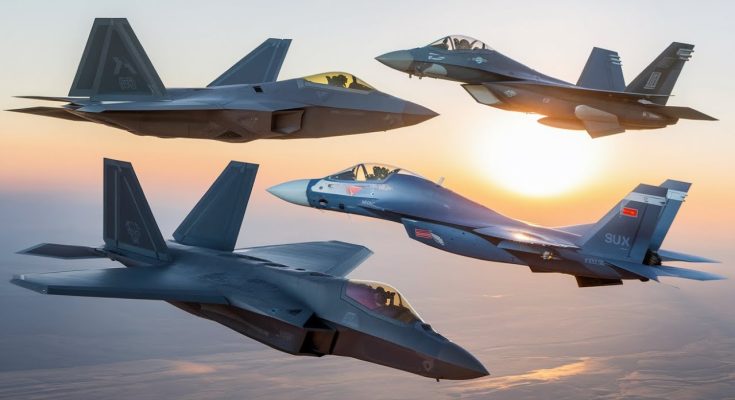Advanced Fighter Jets: A Comparison of the F-22 Raptor, FA-XX, Su-57, and F-35
The landscape of modern air combat has been shaped by the development of advanced fighter jets. These aircraft play pivotal roles in ensuring air superiority, with cutting-edge technologies designed to give them an edge in stealth, maneuverability, and weapons systems. Among the most prominent and anticipated in this category are the F-22 Raptor, FA-XX, Su-57, and F-35. Each represents a different approach to the future of air combat, balancing stealth, speed, and versatility in unique ways.
F-22 Raptor: The Legacy of Stealth and Superiority
The F-22 Raptor, developed by Lockheed Martin for the U.S. Air Force, is regarded as the world’s premier air superiority fighter. Entering service in 2005, the F-22 combines stealth, supercruise (the ability to fly at supersonic speeds without using afterburners), and extreme maneuverability, making it highly effective in both offensive and defensive operations. Its advanced avionics and radar systems give it a significant advantage in detecting and targeting adversaries before they can react. The F-22’s unique design also minimizes its radar cross-section, ensuring it remains undetectable to enemy radar at long ranges.
Despite its prowess, the F-22 is limited in its multirole capabilities, being primarily focused on air superiority. Moreover, the U.S. Air Force has discontinued its production due to high costs and the emergence of more versatile aircraft like the F-35.
FA-XX: The Next-Gen U.S. Navy Fighter
The FA-XX is an emerging program for the U.S. Navy aimed at replacing the aging F/A-18 Hornet and complementing the capabilities of the F-35C on aircraft carriers. The FA-XX is envisioned as a highly versatile platform that balances stealth, range, and the ability to operate effectively from carrier decks. It is speculated to have cutting-edge stealth characteristics similar to the F-22 and F-35, combined with long-range strike capabilities, multi-sensor fusion, and advanced avionics. The FA-XX may also feature a modular design, allowing for rapid upgrades in weapon systems and avionics as technology evolves.
While still in early development, the FA-XX is anticipated to be a critical part of the U.S. Navy’s future air dominance, capable of engaging in both air-to-air combat and ground strikes with a focus on flexibility and survivability in contested environments.
Su-57: Russia’s Stealth Fighter
The Su-57, developed by Sukhoi for the Russian Air Force, is Russia’s answer to advanced Western fighter jets. With a design that emphasizes stealth, speed, and agility, the Su-57 is intended to rival the F-22 and F-35 in both air superiority and multirole strike missions. Unlike Western designs, the Su-57 integrates advanced technologies such as thrust-vectoring engines, which give it superior maneuverability in close-quarters combat. Its radar-absorbing materials and stealthy design, while effective, are often considered less refined than those of the F-22.
The Su-57’s strengths lie in its agility and the ability to carry an array of air-to-air and air-to-ground munitions, but its avionics and sensor fusion are considered less advanced compared to American counterparts. Its production has been slow, and it has yet to reach full operational capability, which limits its impact in the global fighter jet market.
F-35: The Multirole Masterpiece
The F-35 Lightning II is a family of fifth-generation multirole fighters, developed by Lockheed Martin for the U.S. and allied forces. It is available in three variants (F-35A, F-35B, F-35C) and is designed for both air-to-air and air-to-ground operations. The F-35 is a highly versatile stealth fighter that excels in a range of combat scenarios, with exceptional sensor fusion, networked capabilities, and advanced radar. Unlike the F-22, which is dedicated solely to air superiority, the F-35’s versatility makes it a highly effective platform for various missions, including close air support, intelligence, surveillance, and reconnaissance (ISR), as well as electronic warfare.
Its combination of stealth, advanced sensors, and multirole capacity makes the F-35 a cornerstone of modern air forces worldwide. However, the F-35 is not as agile as the F-22 or Su-57, and its speed is limited compared to the F-22’s supercruise capabilities.
Conclusion
In comparing the F-22 Raptor, FA-XX, Su-57, and F-35, each aircraft brings unique strengths to the table. The F-22 remains the undisputed leader in air superiority, thanks to its unmatched stealth, agility, and supercruise capabilities. The FA-XX promises to be a versatile, next-gen naval platform designed for carrier operations. The Su-57 offers exceptional maneuverability and speed but lags behind in terms of avionics and production pace. Finally, the F-35’s versatility and stealth make it the go-to aircraft for a wide variety of roles, although it sacrifices some of the high-speed and maneuvering performance of its competitors. Together, these jets represent the forefront of aerial combat, each suited to its respective mission while showcasing the evolving nature of fighter jet technology.



